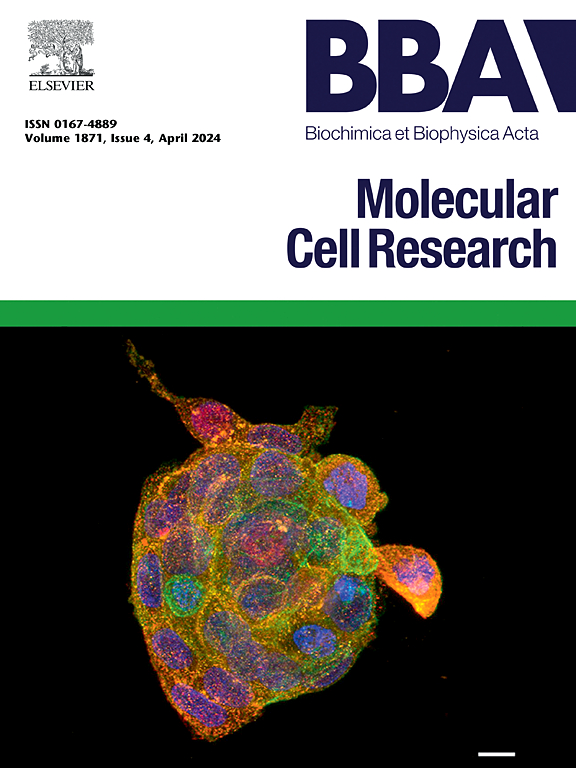POLR1F promotes proliferation and stemness of anaplastic thyroid cancer by activating F2R/p38 MAPK signaling
IF 3.7
2区 生物学
Q1 BIOCHEMISTRY & MOLECULAR BIOLOGY
Biochimica et biophysica acta. Molecular cell research
Pub Date : 2025-04-16
DOI:10.1016/j.bbamcr.2025.119963
引用次数: 0
Abstract
Anaplastic thyroid cancer (ATC) is one of the most aggressive cancers characterized by a rapid growth rate. Dysregulation of RNA polymerase (Pol) is critical for cancer development. However, little is known about its role and mechanism in ATC. In the present study, the expression of Pol family members is screened in a large-cohort proteome containing 113 ATCs and 20 normal thyroid samples. Combined with the mRNA levels and gene dependency scores, we find that RNA Polymerase I Subunit F (POLR1F) is significantly upregulated in ATC tissues with the strongest gene effect among the Pol family members. The results are confirmed in ATC tissues and cell lines, revealing that POLR1F mainly locates in the nucleus and expresses stronger than that in normal thyrocytes. Silencing POLR1F in ATC cell lines significantly inhibit cell proliferation, colony formation, and sphere sizes. POLR1F knockdown dramatically reduces ATC tumor growth in both zebrafish and nude mouse xenograft models. RNA sequencing reveals that the coagulation factor thrombin receptor (F2R) is a downstream target of POLR1F, which participates in the p38 MAPK pathway. POLR1F promotes the H3K4 methylation at the F2R promoter by reducing the binding of demethylase KDM5C to H3K4me3, thereby enhancing F2R transcription. These results demonstrate that POLR1F maintains ATC stemness and growth by activating F2R/p38 MAPK signaling, shedding light on the essential role of POLR1F in ATC progression.
POLR1F通过激活F2R/p38 MAPK信号通路促进间变性甲状腺癌的增殖和分化
甲状腺间变性癌(ATC)是最具侵袭性的癌症之一,其特点是生长速度快。RNA聚合酶(Pol)的失调对癌症的发展至关重要。然而,对其在ATC中的作用和机制知之甚少。本研究在包含113个ATCs和20个正常甲状腺样本的大队列蛋白质组中筛选Pol家族成员的表达。结合mRNA水平和基因依赖评分,我们发现RNA聚合酶I亚单位F (POLR1F)在ATC组织中显著上调,在Pol家族成员中基因效应最强。结果在ATC组织和细胞系中得到证实,表明POLR1F主要位于细胞核中,表达强于正常甲状腺细胞。在ATC细胞系中沉默POLR1F可显著抑制细胞增殖、集落形成和球体大小。在斑马鱼和裸鼠异种移植模型中,敲低POLR1F可显著降低ATC肿瘤的生长。RNA测序显示凝血因子凝血酶受体(F2R)是POLR1F的下游靶点,参与p38 MAPK通路。POLR1F通过减少去甲基酶KDM5C与H3K4me3的结合,从而促进F2R启动子上H3K4的甲基化,从而增强F2R的转录。这些结果表明,POLR1F通过激活F2R/p38 MAPK信号维持ATC的生长和生长,揭示了POLR1F在ATC进展中的重要作用。
本文章由计算机程序翻译,如有差异,请以英文原文为准。
求助全文
约1分钟内获得全文
求助全文
来源期刊
CiteScore
10.00
自引率
2.00%
发文量
151
审稿时长
44 days
期刊介绍:
BBA Molecular Cell Research focuses on understanding the mechanisms of cellular processes at the molecular level. These include aspects of cellular signaling, signal transduction, cell cycle, apoptosis, intracellular trafficking, secretory and endocytic pathways, biogenesis of cell organelles, cytoskeletal structures, cellular interactions, cell/tissue differentiation and cellular enzymology. Also included are studies at the interface between Cell Biology and Biophysics which apply for example novel imaging methods for characterizing cellular processes.

 求助内容:
求助内容: 应助结果提醒方式:
应助结果提醒方式:


